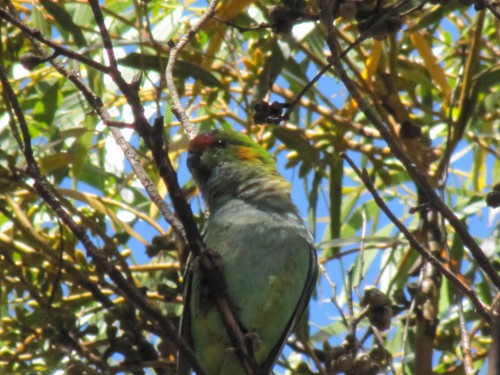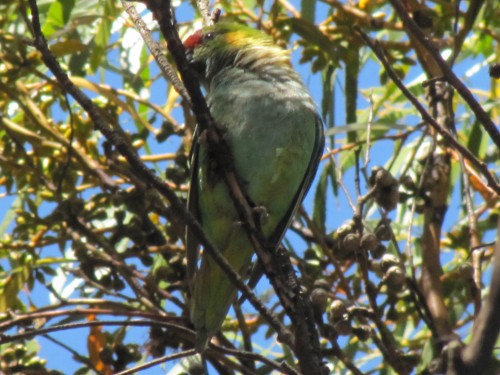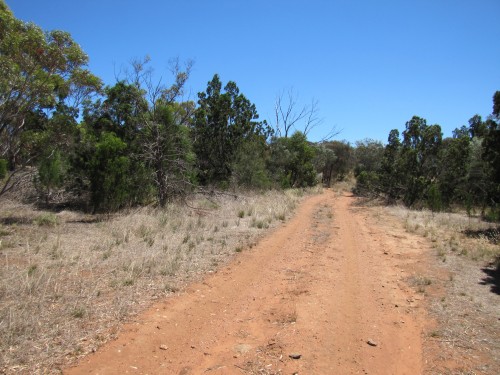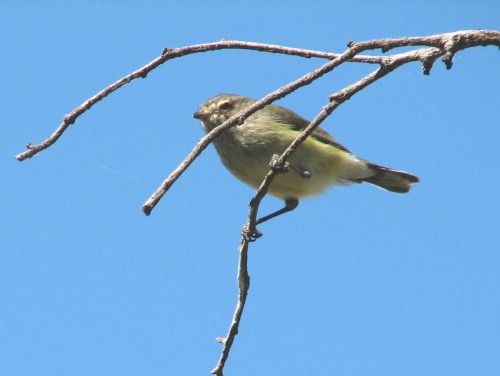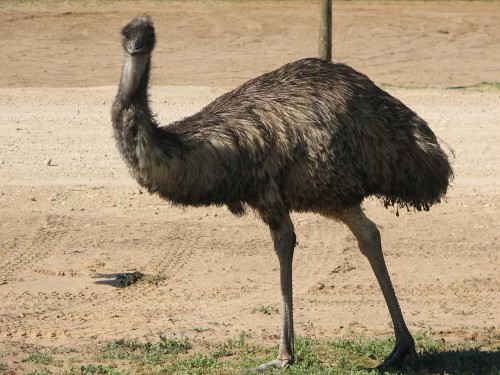Purple-crowned Lorikeets at Brown’s Road, Monarto
I have been trolling through a few photos taken over two years ago, looking for some I haven’t shared here on this site. On this occasion I took John Tongue and family birding to a site about 15 minutes’ drive from home. Brown’s Road, near Monarto just west of Murray Bridge here in South Australia is something of a birding mecca for birders in this locality. The Birds SA people, as well as individuals, often arrange field trips to this locality.
Strange as it may seem, after living so close for over 25 years, this was my first visit. It was quite a warm day and the birding was a little slow but we did see a few good species, including the Purple-crowned Lorikeets shown in the photos today. Below I have also shown the vegetation typical of this area. While it is predominantly mallee eucalypt, there are also consideration native pine stands (Callitris spp) and quite a few introduced plant species due to the area being planted up several decades ago.
Apostlebirds in South Australia
Whenever we camped at or visited Lake Hattah in the Hattah-Kulkyne National Park in Victoria we always looked forward to seeing the family of Apostlebirds occupying the camping ground. They are gregarious and noisy, often bossing other species out of any food scraps we may drop on the ground.
As we drive over to visit our family in Sydney we start looking for this species along the road between Hay and Narrandera. On most trips we get good views of them crossing the road in front of our car as we speed along.
As a result of these regular sightings we have become rather attracted to these interesting birds. Part of this fascination is that they make a bowl shaped mud nest; very few Australian birds construct their nest with mud. The other fascinating aspect of this species is that they are relatively uncommon here in South Australia.
For some years I have known of a family living around the gardens and grounds of the Peterborough Hospital in the mid-north of the state. My sister-in-law is the cook at the hospital, and she has told me that these bold birds will even come onto the veranda and into through the doors of the wards which open onto the veranda. Over recent years we have visited our relatives a number of times, and despite searching the area I have failed each time to see these birds – except once many years ago.
Many years ago I did manage to record Apostlebirds near the township, but this was in the early 1980s and again in the 1990s. Even earlier than that I saw them during a family picnic at Dawson Gorge, about 30km north-east of Peterborough.
In recent months, however, there have been a growing number of reports of this species in other spots in the mid-north, including Gladstone, Laura, Stone Hut and more recently at Watervale. On a recent visit to my daughter in Clare we went for a drive through this area. As we drove through Gladstone, I was pleased to see two Apostlebirds fly across the road in front of the car.
It seems that this species is expanding its range here in South Australia.
Further reading:
The chase is on
A little while ago I was outside in the garden attending to one of those mundane jobs around the house. Okay, I’ll admit I was checking the washing hanging out to dry. My attention was suddenly grabbed by a great uproar coming from the local resident honeyeaters. They were creating a terrible noise, so I knew that something was disturbing them big time.
As I looked around a Collared Sparrowhawk (see photo above) landed on the power line coming in towards the house. Next thing, it took off after its lunch – a Common Starling. Well, I’m not sure if it actually caught its prey. The last I saw of them was the starling zooming a full speed across the garden and then weaving through the mallee scrub behind our house, hotly pursued at full speed by the hawk. I was amazed at how fast they were going, but when you consider those sharp talons, one can hardly blame the starling for getting a move on.
A little bird encounter
I haven’t ventured out much over the last few weeks. It has been a wet winter so far and we’ve have many rain-sodden days. On the days where it hasn’t rained, we’ve either had frequent showers, overcast skies or bitterly cold winds – sometimes all three. The weather has not encouraged anyone to be out in it. Added to my misery of being stuck indoors was the fact that I’ve been very sick over that period. Bronchitis (and several other health issues) has made life even more miserable than it already was.
I’m slowly on the mend, and today we had a lovely winter’s day, typical of many days at this time of the year. After a cold night and a near frosty morning, the sun shone brightly all day. I even managed a half hour of reading while sitting in the sun on our back veranda. It was delightful, and I received a good dose of vitamin D as a bonus. I hope it will help the healing process.
At one stage I wandered up into our small patch of mallee scrub. Mallee trees are eucalypts and are very common in this part of South Australia. As I slowly walked through the trees a small group of Weebills sat calling sweetly in the branches not two metres above my head. They weren’t at all perplexed by my presence.
Lovely.
Birding at 100kph on the Hay Plains
My wife and I have just returned from a road trip to Sydney to visit family. Grandchildren can be so persuasive; “We insist you come to stay with us,” said Mr Nearly Five Years Old.
We didn’t get to do much birding because of the wet weather, and the fact that I came down with a severe case of bronchitis while there; as I write this I’m still in the throes of that dreaded lurgy. (“Cough! Cough!”)
While we have flown over to Sydney on several occasions – it’s nearly 1400km each way – we prefer to drive because we enjoy the passing scenery, flora and fauna and the birds, of course. Yes, it’s tiring travelling non-stop for two full days, but we take it in turns to drive. When I’m at the wheel my wife records the birds I see and can identify along the road. Identification can be challenging when hurtling along at 100kph on a busy highway. And when it’s my wife’s turn to drive I can give a little more attention to what is flying around, or sitting on the roadside – or even on the road itself.
I usually try to arrange to be the passenger when we are crossing the Hay Plains between the towns of Balranald and Hay in far western New South Wales. This long stretch of road has huge expanses of grassland and saltbush with only the occasional tree until the last 20km just east of Balranald. Usually the birding along the 130km road is excellent with plenty of birds of prey. On this trip however, I saw few birds other than Emus.
Usually I count on seeing perhaps up to ten or a dozen Emus along this road, but on this occasion I estimate there were between 50 and 80. I didn’t count them but one loose flock alone numbered around 20. as for the rest there were numerous groups of two, three or four. It was certainly the most I can ever remember seeing on this stretch of road, one we’ve travelled on many occasions when travelling to Sydney to visit family. (Now that we have grandchildren there as an added incentive, we are travelling over there up to three times annually.)
Related articles:
- Birding on the Hay Plains – articles from my archives
